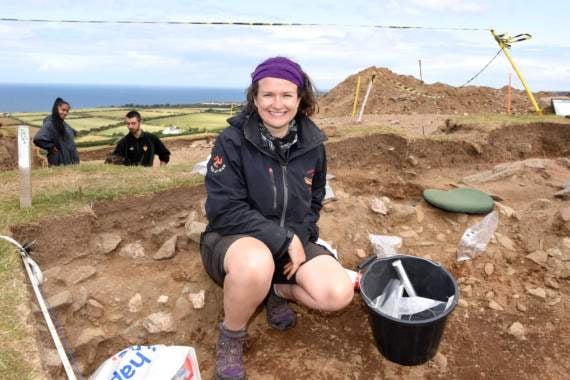Archaeologists are celebrating a spectacular find that could provide a new insight into the lives of our ancestors 4,000 years ago.
Perched on a hillside overlooking the sparkling sea between Glen Mooar and Glen Wyllin, it’s easy to see, in the summer sunshine, why people in prehistory would choose this site as a place to live and bury their dead.
Here, archaeologists have excavated a stone lined grave dating back to the early Bronze Age, containing human bones and a complete necklace of jet beads - the first such discovery in the Isle of Man.
Given the jet is likely to have come from Whitby in North Yorkshire, it shows how inter-connected the people of Bronze Age Britain were, even with a little island in the middle of the Irish Sea.
The team from the Round Mounds project have been excavating the dramatic site at Berk Farm for three years now.
This year’s season at the dig ended last week, and given the exciting finds already unearthed, the archaeologists are keen to return next year.
Dr Rachel Crellin, co-director of the Round Mounds project and lecturer at the University of Leicester in later pre-history, said: ’We’ve had a really great season this year.
’We’ve revealed much more about the structure of the mound and the activity that was happening here in the Bonze Age, about 4,000 years ago.
’We found two more cremation burials and the icing on the cake for us has been the discovery of a large pit containing an inhumation burial where the individual was buried with a jet spacer plate necklace.
’The necklace is the first of its kind to be found in the Isle of Man. We are pretty sure it’s complete. It’s a really beautiful object.
’But the real value of it is that it came from a grave where we have all the information about the person who died and we will be able to do lots more research on it and reveal much more about life at this time.
’The jet necklace probably comes from Whitby in Yorkshire and so it tells us about connections and trade, travel and movement between places in the Bronze Age.’
The discovery was made on July 4 by Rachel’s fellow director Dr Chris Fowler, from Newcastle University.
He said: ’The beads were very shiny, almost like they were made out of plastic. They were positioned where they would have been worn around the chest.
’It was a real team effort to record where everything was. The beads were stacked slightly on top of each other.’
No fewer than 122 jet beads were unearthed, mostly small and barrel-shaped but among them some beautifully decorated spacer plates with a chevron-shaped design. The clasps were found too. Less than 100 such necklaces have been found in the British Isles, 60 of them from Scotland.
But this is a first discovered in the island.
The jet has to be kept wet to ensure it doesn’t crack.
It will have to be properly conserved before the necklace can be put back together but the aim is ultimately to do just that and hopefully put it on display in the Manx Museum.
Remarkably the grave itself, dating from between 2,200BC and 1,900BC, was undisturbed, having been protected over the centuries by the turf and soil mound.
Just the pelvis and femur remained of the body, but it was enough to know that this was an adult buried in a crouched position on its right hand side.
Rachel said given the discovery of the necklace the presumption would be that this was the body of a woman but this was not necessarily the case.
As well as the body with the necklace, archaeologists have found cremated bones from seven burials in the ancient monument.
They have also discovered Bronze Age flint tools including scrapers and arrow heads.
And there are indications that the site was occupied much earlier still, with the discovery of Neolithic pottery below the level of the mound and in pits found beyond the stone kerbs that mark its perimeter.
While we know something about how the people of the early Bronze Age treated their dead we know very little about how they lived.
Few settlements sites from this period are known as their dwellings didn’t leave any substantial remains.
With still much more to be learned about the present excavation, and possibly two more round mounds on the site still to be investigated, it’s clear there is much work to be done by the team.
But future digs will depend on funding being secured.
Funding this year has come from Manx National Heritage, Newcastle University and the University of Leicester.
Over the course of the project grants and support have also been provided by Culture Vannin and Northern Archaeological Associates.
Site owner Robert Cannell remembers a wet and windy day in October 2016 when two female archaeologists, including Dr Crellin, knocked at his door inquiring about the round mounds on his land.
He said: ’My family have owned this property for 150 years.
’Generations have looked up the hill and wondered what these mounds might contain.
’Any landowner is just a steward for their lifetime.’



.jpeg?width=209&height=140&crop=209:145,smart&quality=75)
.jpeg?width=209&height=140&crop=209:145,smart&quality=75)
Comments
This article has no comments yet. Be the first to leave a comment.